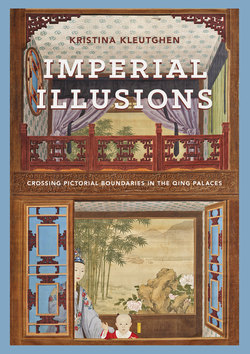Читать книгу Imperial Illusions - Kristina Kleutghen - Страница 63
На сайте Литреса книга снята с продажи.
Оглавлениеprofessor Inácio Vieira (1678–1739) produced his own treatises on optics and perspective by studying the image distortions found in quadratura.94 Although the effects of Castiglione’s five years in Portugal on his paintings produced for the Qing emperors remain unexplored, Portugal seems to have proven a particularly fertile environment in which Castiglione honed his skills in perspective and monumental illusionism required for quadratura that would ultimately lead to the development of scenic illusions in China.
Castiglione arrived in Beijing in 1715, taking up his post at the same time as the climax of the Chinese Rites controversy, which had a significant impact on the missionary artists at the Qing court. The Jesuit policy of acculturation and accommodation, which originated in Asia with Alessandro Valignano’s work at the short-lived Japanese mission, manifested itself in China through the Jesuits’ adoption of the dress, language, and customs of the educated elite, including the use of scholarly Confucian terms and concepts to explain Christianity. In 1692, although Kangxi himself had not converted, he issued an edict of toleration for Christianity, and promoted an atmosphere of liberalism and intellectual exchange. Other Catholic groups evangelizing in China in the seventeenth century, including the Franciscans, Dominicans, and Augustinians, vehemently disagreed with the Jesuit acculturation policy and refused to adopt Chinese cultural customs. This extended even to the very terms used to name the divine: the Jesuits permitted the traditional Chinese terms tian (heaven) and Shangdi (God, literally, “Supreme Emperor”) be used for these Christian concepts, but the other groups did not, preferring the neologism Tianzhu (Lord of heaven) for God. Furthermore, they argued that the essential Chinese practice of ancestor veneration, common to both elite Confucian customs as well as traditional folk beliefs, was incompatible with Christianity in general and the First Commandment in particular. In contrast, the Jesuits argued that ancestor veneration was more a social custom than a sacred rite, and that the veneration of Confucius was a civil matter. They promoted the successes achieved by their acculturation policies as evidence in support of their position, successes that also incited envy among their missionary competition for achieving a Christian China. The result of these divisions was the Chinese Rites controversy, which peaked in 1715 when Pope Clement XI (r. 1700–21) issued the bull Ex illa die, which reinforced a 1704 decree that Chinese ancestor worship and Confucian rituals conflicted with Catholic teaching. Henceforth, Pope Clement declared, these ancient customs were prohibited among Chinese converts.
Declaring this unacceptable and nonsensical, the previously tolerant Kangxi banned Christian evangelism in China in 1721, but allowed the Jesuits to stay on at his court as respected teachers and advisors. Kangxi’s successor, Yongzheng, took a more aggressive stance: he banned Catholicism outright at the beginning of his reign, ordered all Chinese Christians to renounce their foreign faith, and expelled all missionaries to Macau except those directly serving the court in technical capacities. Yongzheng’s division of the missionaries in this way enabled Castiglione to stay on as a court artist, and he later began to paint for Yongzheng’s fifth son, the prince Hungli. When Hungli ascended the throne
